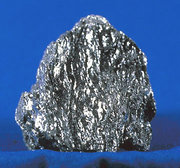Hematite
|
|
| Hematite | |
|---|---|
| General | |
| Category | Mineral |
| Chemical formula | iron (III) oxide, Fe2O3 |
| Identification | |
| Colour | Metallic grey to earthy red |
| Crystal habit | Tabular to thick crystals |
| Crystal system | Hexagonal (rhombohedral) |
| Cleavage | None |
| Fracture | Uneven to subconchoidal |
| Mohs Scale hardness | 5.5 - 6.5 |
| Luster | Metallic to splendent |
| Refractive index | Opaque |
| Pleochroism | None |
| Streak | Bright red to dark red |
| Specific gravity | 4.9 - 5.3 |
| Fusibility | ? |
| Solubility | ? |
| Major varieties | |
| Specularite | |
Hematite (AE) or haematite (BE) is the mineral form of Iron (III) oxide, (Fe2O3), one of several iron oxides. The ore sometimes contains slight amounts of titanium. When shaped into ornaments, it is often called black diamond.
Hematite.jpg
Hematite is a very common mineral, coloured black to steel or silver-gray, brown to reddish brown, or red. It is mined as the main ore of iron. Varieties include Bloodstone, Iron Rose, Kidney Ore, Martite, Paint Ore, Specularite (Specular Hematite), Rainbow Hematite and Titano-hematite. While the forms of hematite vary, they all have a rust-red streak.
Deposits of grey hematite are typically found in places where there has been standing water or mineral hot springs, such as those in Yellowstone. The mineral can precipitate out of water and collect in layers at the bottom of a lake, spring, or other standing water. But hematite can also occur without water, as the result of volcanic activity.
Clay-sized hematite crystals can also occur as a secondary mineral formed by weathering processes in soil, and along with other iron oxides or oxyhydroxides such as goethite, is responsible for the red color of many tropical, ancient, or otherwise highly weathered soils.
The name hematite is derived from the Greek word for blood, since sometimes hematite can be red, as in Rouge, a powderized form of hematite. It shares this root with the word hemoglobin. Hemoglobin is the oxygen-transporting molecule in red blood cells, the iron of which causes blood to be red. The color of hematite lends it well in use as a pigment.
Especially nice specimens of hematite come from England, Mexico, Brazil, Australia and the Lake Superior region of the United States and Canada.
Hematite on Mars
Hematite can be formed by aqueous processes, weathering processes, or without water. In 2004, NASA's Mars rover Opportunity discovered small spheres believed to be made partly or mostly of hematite. The spheres are only a few millimeters in diameter and are believed to have formed as rock deposites under watery conditions billions of years ago when Mars was a wetter world. The rover used its instruments to test how the hematite found on Mars at Meridiani Planum was formed.
See also
External links
- Mars spheres image (http://marsrovers.jpl.nasa.gov/gallery/press/opportunity/20040212a/07-ml-3-soil-mosaic-B019R1_br.jpg).
- Mars trench image showing a shiny texture of half-buried spheres (http://marsrovers.jpl.nasa.gov/gallery/press/opportunity/20040219a/08-AY-3-shiny-B026R1_br.jpg) (dark line is equipment shadow)de:Hämatit


